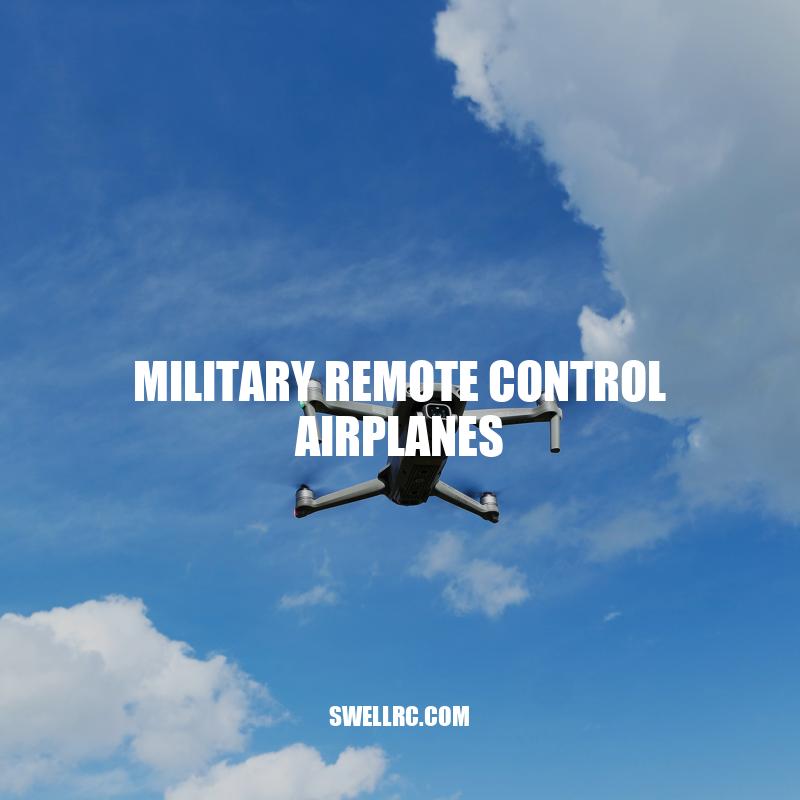Military RC Airplanes: Advantages, Types, Risks, and Future
Military remote control airplanes, also known as unmanned aerial vehicles or UAVs, have revolutionized the way military operations are carried out. These aircraft are operated remotely through a ground-based control system and are widely used for various purposes including, but not limited to surveillance, reconnaissance, and targeted attacks. UAVs were first used in the military during the Vietnam War for reconnaissance purposes. However, in recent years, the use of UAVs has increased significantly, particularly for targeted attacks on high-value targets. The ability of UAVs to operate in areas where manned aircraft cannot has given military forces a significant advantage. Additionally, the real-time situational awareness provided by UAVs has greatly enhanced the effectiveness of military operations.
Types of Military RC Airplanes
There are various types of military remote control airplanes, each designed for a specific purpose. Here are some of the most common ones:
- Reconnaissance Drone: Equipped with high-resolution cameras and infrared sensors, these drones provide real-time monitoring and intelligence gathering capability. They are extensively used by military forces for surveillance, reconnaissance, and intelligence gathering.
- Strike Drone: Also known as Combat UAVs, they are equipped with missiles or bombs for targeted attacks. These drones can operate in high-risk environments without putting human lives in danger.
- Cargo Drone: Used extensively for transporting cargo and personnel to remote destinations. They are equipped with cargo bays and can be used for a variety of missions, including logistics and transportation operations.
- Experimental Drone: These drones are used by military forces for research and development purposes. They are equipped with advanced technology and sensors, which aid in the development of new technologies and techniques.
The accurate and fast remote control and the sophisticated sensing devices make drone operations within a nation’s borders even more attractive. The acquisition and deployment of such aircraft has even moved beyond the military and become available to civil authorities. For example, a few police departments in the United States have obtained drones for surveillance purposes.
What are remote controlled aircraft called?
Remote controlled aircraft are called Unmanned Aerial Vehicles (UAVs). These aircraft have no on-board crew or passengers and can be automated ‘drones’ or remotely piloted vehicles (RPVs). They can fly for long periods of time at a controlled level of speed and height and have a role in many aspects of aviation, such as military, agriculture, and aerial photography. If you’re interested in UAVs, there are many websites that provide information and products related to this field, such as DJI, Yuneec, and Parrot.
Benefits of Military RC Airplanes
The use of military remote control airplanes provides several key benefits for military forces, including:
- Situational Awareness: UAVs provide real-time information on the battlefield and help to increase situational awareness for the military personnel in charge.
- Rapid Deployment: Drones can be quickly deployed in a crisis, and are capable of reaching targets that may be difficult to access by troops on the ground.
- Operational Efficiency: Once deployed, drones can operate for extended periods without the need for refueling, reducing the need for costly logistical support.
- Reduced Risk: The use of drones helps to reduce risks to human pilots in dangerous missions, by allowing missions to be carried out remotely from a safe distance.
Interesting Fact: The General Atomics MQ-9 Reaper is one of the most versatile and widely used military drones in service today. It has a range of over 1,800 miles, can fly for up to 27 hours, and is equipped with advanced electronics and sensors that allow it to carry out a variety of missions, including reconnaissance, surveillance, and targeted attacks.
Additional semantically related keywords: versatility, General Atomics MQ-9 Reaper, advanced electronics and sensors.
To know more about these sophisticated military remote control airplanes, check out the official website of General Atomics.
What are the advantages of RC planes?
RC planes have certain advantages as compared to other flying devices. Mainly used for recreational purposes and by beginners in aero flying, one of the most notable advantages of RC planes is that they can promote creativity and practical building skills. They are much cheaper as compared to drones and therefore, suitable for beginners who want to try out flying without breaking the bank.
Risks and Challenges of Military RC Airplanes
While military remote control airplanes offer many benefits, there are also several risks and challenges associated with their use, such as:
- Technological Malfunction: Drones are complex machines that rely on many different components and subsystems. A malfunction in any of these systems could cause the drone to crash or become lost.
- Cybersecurity Risks: Military UAVs rely on a ground-based control system to operate; if this system is compromised by cyber attacks, the security of the operation may be compromised.
- Privacy Concerns: UAVs are equipped with advanced cameras and sensors that can potentially capture sensitive information about individuals or communities.
- Regulatory Compliance: Laws and regulations governing the use of remote control airplanes are still evolving, and military forces must comply with these regulations even in times of conflict.
| Risks and Challenges | Details |
|---|---|
| Technological Malfunction | A malfunction in any component could cause the drone to crash or be lost |
| Cybersecurity Risks | The ground-based control system is vulnerable to cyber attacks |
| Privacy Concerns | UAVs equipped with advanced cameras and sensors that can capture sensitive information |
| Regulatory Compliance | Laws and regulations governing the use of UAVs are still evolving, and the military must comply with regulations |
Interesting Fact: There is an ongoing debate about the ethical implications of using military remote control airplanes. Some argue that the use of UAVs is a safer and more efficient way of carrying out military operations, while others argue that their use raises serious concerns about civilian casualties, privacy, and accountability.
Additional semantically related keywords: ethical implications, civilian casualties, accountability.
What are the problems with unmanned aerial vehicles?
Unmanned aerial vehicles (UAVs) come with their own set of problems. They can be hijacked or manipulated, which is a major safety concern. Additionally, they can trespass into authorized areas such as airports and military zones, posing a security risk. While UAVs have advantages in surveillance, there can be severe consequences when used by unauthorized third parties.
Conclusion
Military remote control airplanes have revolutionized modern warfare, providing a safer and more efficient way of carrying out military operations. They offer numerous benefits, including real-time situational awareness, quick deployment, and increased operational efficiency. However, there are also significant risks and challenges associated with their use, such as technological malfunctions, cybersecurity risks, privacy concerns, and regulatory compliance. The development and use of military remote control airplanes are expected to continue to grow in the future, with advancements in technology leading to even more capabilities. As they become more sophisticated, it is essential to prioritize risk mitigation and regulation to ensure their safe and ethical deployment.
Overall, the use of military remote control airplanes is a complex issue, with many advantages and disadvantages to consider. While they undoubtedly contribute to military superiority, their use raises important questions about safety, privacy, and accountability. It is up to military forces and policymakers to weigh these factors carefully and navigate the ethical implications of deploying remote control aircraft in conflict and in peacetime.



